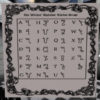The script known as Theban has no clearly established origin, and little lore directly linked to it by itself. If anything, the history of the Theban script runs parallel to the history of renaissance occultism. It’s typically considered a “cypher” as it has no observable connection to any strictly linguistic script. Its structure runs mostly parallel with Latin with some simple linguistic substitutions. They use the Theban character for v to stand in for u and w, and i for j.
Many of the minor features of each of the characters are also present in the collection of occult symbols known as sigils which is just a word meaning seal, and these are mostly pictographic with some few characters included. One cypher in particular was associated with the Rosicrucian order. The strange system of lines can be “read” by understanding where the stops correspond to on the Rosicrucian compass rose. Some of this symbolism is difficult to track down examples of, as it is in fact still being used.
The first confirmed use of this script was by Heinrich Cornelius Agrippa. During the renaissance period, the time of Agrippa and his peers, scientific inquiry was beginning to take root in the practices of individuals like Renee Descartes among others, but occultism was running more or less equally alongside it at the time.
Thebes itself is a city in Greece and the supposed sight of many formative legends. The cypher itself is called Theban because it was supposedly originally created by one honorius of Thebes, a character similar to Hermes Trismegistus perhaps.
The works of Cornelius Agrippa influenced even figures like Descartes, as occultism’s standing as a philosophical “science” was almost equal to that of natural philosophy at the time. The lines between the two were not even clearly drawn.
Were the Rosicrucian’s alchemists? Yes. They still are in a sense. Alchemical philosophy went on to influence other branches of hermetic philosophy. The preponderance of works purporting to depict demonic seals and methods for summoning of such beings were as common as they were because the material universe was considered primarily demonic in nature.
Is it speculated that the script was used as a secret code? Oh, that’s confirmed as Agrippa avoided publishing more than a few of his works though he did share the material around his peers who likewise understood this script.
Theban is also known today as the witches alphabet as it was adopted with the founding of Gardnerian Wicca as a tradition. The people who “revived” Wicca drew from renaissance occultism among other sources as well as old druid lore and the like. Gardnerian Wicca is sometimes described as a combination of hermetic philosophy and druid theology, and even though others would go on to found their own traditions of Wicca, they took with them the education they received originally, including the “witches alphabet” though it didn’t originate with them. Isn’t syncretism grand?
Your thoughts are welcome. Be well friends.
Travis Saunders
Dragon Intuitive
~science,mysticism,spirituality~



Leave a Reply